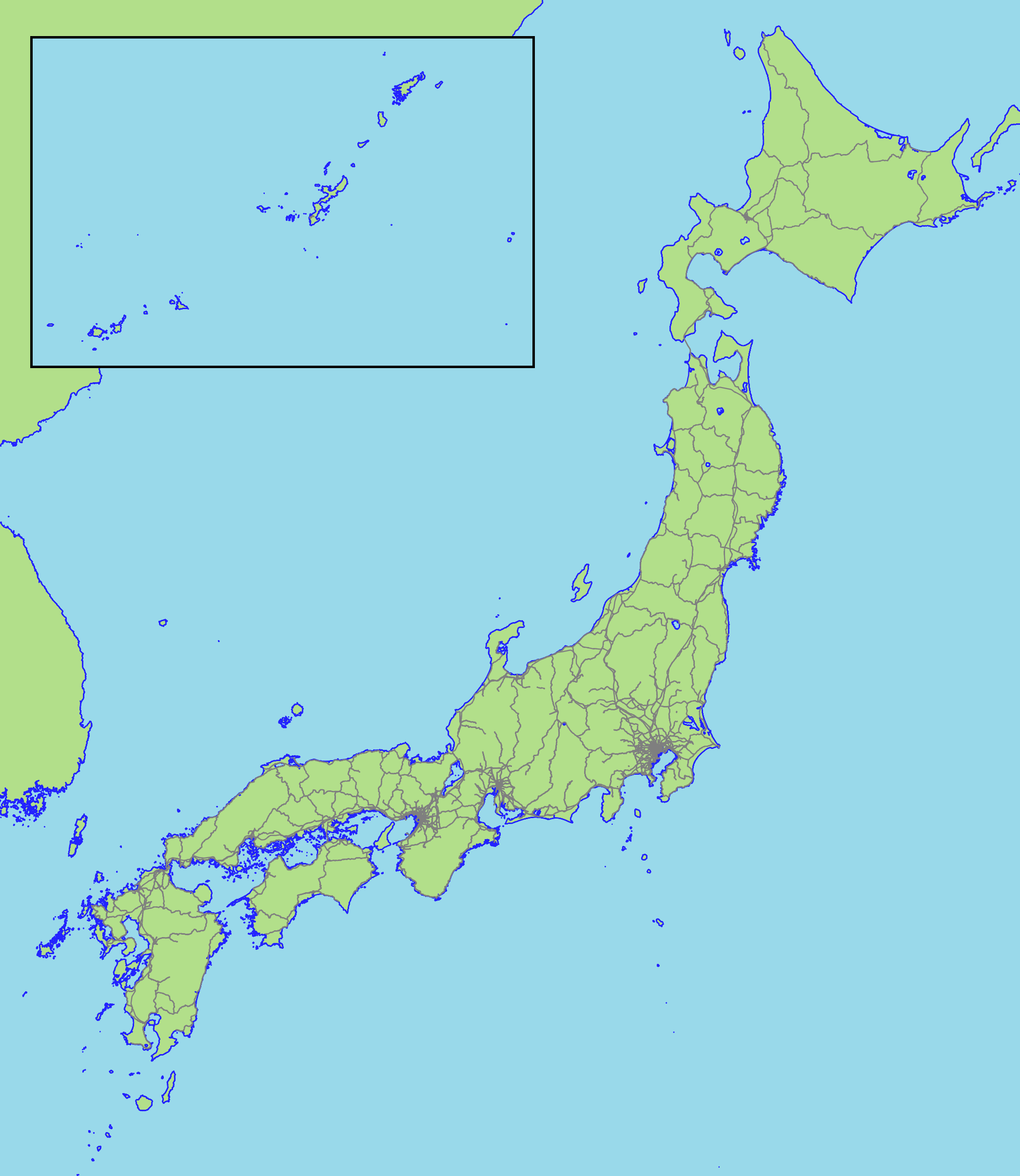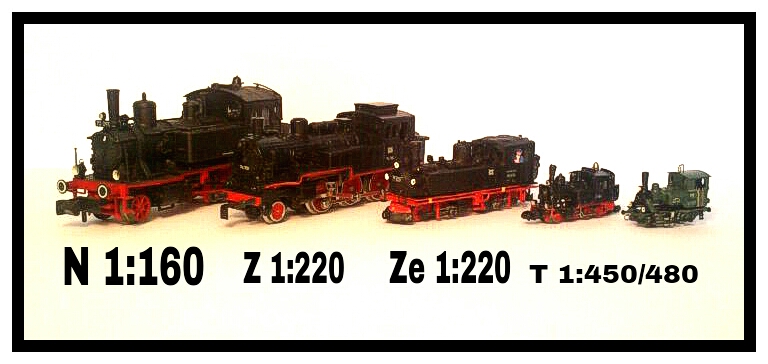|
ZZ Scale
ZZ scale (1:300) is a model railroad scale with a standard gauge of . Models for the scale are produced exclusively by Bandai, and depict Japanese prototypes such as Shinkansen trains. To date, no other traditional scale railway support exists for the scale. However the field of miniature war games has a large selection of buildings, trucks and other accessories at 1:285 scale and 1:300. Several suppliers make these in painted and unpainted form, and at several levels of quality. Until the 2006 announcement of T scale, ZZ scale was the smallest commercially available scale for model railroads. See also *Z scale * Rail transport modelling scales * Model railway scales Rail transport modelling uses a variety of scales (ratio between the real world and the model) to ensure scale models look correct when placed next to each other. Model railway scales are standardized worldwide by many organizations and hobbyist ... Model railroad scales {{model-rail-stub ... [...More Info...] [...Related Items...] OR: [Wikipedia] [Google] [Baidu] |
Model Railroad
Railway modelling (UK, Australia, New Zealand, and Ireland) or model railroading (US and Canada) is a hobby in which rail transport systems are modelled at a reduced scale. The scale models include locomotives, rolling stock, streetcars, tracks, signalling, cranes, and landscapes including: countryside, roads, bridges, buildings, vehicles, harbors, urban landscape, model figures, lights, and features such as rivers, hills, tunnels, and canyons. The earliest model railways were the 'carpet railways' in the 1840s. The first documented model railway was the Railway of the Prince Imperial (French: Chemin de fer du Prince impérial) built in 1859 by emperor Napoleon III for his then 3-year-old son, also Napoleon, in the grounds of the Château de Saint-Cloud in Paris. It was powered by clockwork and ran in a figure-of-eight. Electric trains appeared around the start of the 20th century, but these were crude likenesses. Model trains today are more realistic, in addition to bein ... [...More Info...] [...Related Items...] OR: [Wikipedia] [Google] [Baidu] |
Standard Gauge
A standard-gauge railway is a railway with a track gauge of . The standard gauge is also called Stephenson gauge (after George Stephenson), International gauge, UIC gauge, uniform gauge, normal gauge and European gauge in Europe, and SGR in East Africa. It is the most widely used track gauge around the world, with approximately 55% of the lines in the world using it. All high-speed rail lines use standard gauge except those in Russia, Finland, and Uzbekistan. The distance between the inside edges of the rails is defined to be 1435 mm except in the United States and on some heritage British lines, where it is defined in U.S. customary/Imperial units as exactly "four feet eight and one half inches" which is equivalent to 1435.1mm. History As railways developed and expanded, one of the key issues was the track gauge (the distance, or width, between the inner sides of the rails) to be used. Different railways used different gauges, and where rails of different gauge met – ... [...More Info...] [...Related Items...] OR: [Wikipedia] [Google] [Baidu] |
Bandai
is a Japanese multinational toy manufacturer and distributor headquartered in Taitō, Tokyo. Its international branches, Bandai Namco Toys & Collectables America and Bandai UK, are respectively headquartered in Irvine, California and Richmond, London. Bandai is a subsidiary of Bandai Namco Holdings and is the parent company's core toy production division. From 1981 until 2001, Bandai produced video game consoles. Bandai was founded by World War II veteran Naoharu Yamashina as Bandai-Ya on July 5, 1950 as the corporate spin-off of a textile wholesaler. The company began as a distributor of metallic toys and rubber swimming rings, before moving to metal cars and aircraft models. It was renamed Bandai Co., Ltd. in 1961 and achieved considerable success with its action figures based on the anime ''Astro Boy''. History Origins and success with toys (1947–1968) In 1947, Naoharu Yamashina began working for a Kanazawa-based textile wholesaler. The eldest son to a rice retailer, Ya ... [...More Info...] [...Related Items...] OR: [Wikipedia] [Google] [Baidu] |
Rail Transport In Japan
Rail transport in Japan is a major means of passenger transport, especially for mass and high-speed travel between major cities and for commuter transport in urban areas. It is used relatively little for freight transport, accounting for just 0.84% of goods movement. The privatised network is highly efficient, requiring few subsidies and running with extreme punctuality. Overview Rail transport services in Japan are provided by more than 100 private companies, including * Six Japan Railways Group (JR) regional companies (state owned until 1987) which provide passenger services to most parts of Hokkaido, Honshu, Shikoku, and Kyushu; * The nationwide JR freight company; and * 16 major regional companies which provide railway services as part of their corporate operations. There are also dozens of smaller local private railways. Many of the private rail companies rank among the top corporations in the country. Railways were built by private corporations developing integrated ... [...More Info...] [...Related Items...] OR: [Wikipedia] [Google] [Baidu] |
Shinkansen
The , colloquially known in English as the bullet train, is a network of high-speed railway lines in Japan. Initially, it was built to connect distant Japanese regions with Tokyo, the capital, to aid economic growth and development. Beyond long-distance travel, some sections around the largest metropolitan areas are used as a commuter rail network. It is operated by five Japan Railways Group companies. Over the Shinkansen's 50-plus-year history, carrying over 10 billion passengers, there has been not a single passenger fatality or injury on board due to derailments or collisions. Starting with the Tokaido Shinkansen () in 1964, the network has expanded to currently consist of of lines with maximum speeds of , of Mini-Shinkansen lines with a maximum speed of , and of spur lines with Shinkansen services. The network presently links most major cities on the islands of Honshu and Kyushu, and Hakodate on northern island of Hokkaido, with an extension to Sapporo under constru ... [...More Info...] [...Related Items...] OR: [Wikipedia] [Google] [Baidu] |
285 Scale , including "Model 85"
* 1985 (other)
* List of highways numbered
{{Numberdis ...
85 may refer to: * 85 (number) * one of the years 85 BC, AD 85, 1885, 1985, 2085 See also * * M85 (other) M85 or M-85 may refer to: Military * M85 machine gun, a machine-gun used in the M60 Patton series of tanks * Zastava M85, an assault rifle developed and manufactured by Zastava Arms * Parker-Hale M85 a sniper rifle. Places * Messier 85, a lenti ... [...More Info...] [...Related Items...] OR: [Wikipedia] [Google] [Baidu] |
T Scale
T gauge (1:450 or 1:480) is a model railway scale with a track gauge of , referred from "Three-millimeter gauge" or "Third of N scale". It was introduced at the Tokyo Toy Show in 2006 by KK Eishindo of Japan, and went on sale in 2007. It is the smallest commercial model train scale in the world (with ZZ scale being second smallest). Since mid-2009, Railway Shop (Hong Kong) is the exclusive licensed manufacturer. The models are powered with a battery-powered throttle (with optional AC adapter) at a maximum output of 4.5 V DC. To improve power pickup and tractive effort, the powered cars are fitted with magnetic wheels, and the track has steel rails. The first train released is the Japanese 103 series commuter train in different versions. Each standard trainset comes with two powered cars, which are located in the centre of the train. The front and rear cars are equipped with directional headlights. The tiny pantographs are made of etched stainless steel. The Hankyu Rail ... [...More Info...] [...Related Items...] OR: [Wikipedia] [Google] [Baidu] |
Z Scale
Z scale is one of the smallest commercially available model railway scales (1:220), with a track gauge of . Introduced by Märklin in 1972, Z scale trains operate on 0–10 volts DC and offer the same operating characteristics as all other two-rail, direct-current, analog model railways. Locomotives can be fitted with digital decoders for independent control. Model trains, track, structures, and human/animal figures are readily available in European, North American, and Japanese styles from a variety of manufacturers. History Z scale was introduced by the German model train manufacturer Märklin in 1972 at the Nuremberg Toy Fair. It was the brainchild of Helmut Killian, Märklin's head design engineer at the time. The letter ''Z'' was chosen to designate the new scale, its place as the last character of the German and English alphabets signaling the thought that there would never be a smaller commercial model railway scale. While there have been attempts since then to ... [...More Info...] [...Related Items...] OR: [Wikipedia] [Google] [Baidu] |
Rail Transport Modelling Scales
Rail transport modelling uses a variety of scales (ratio between the real world and the model) to ensure scale models look correct when placed next to each other. Model railway scales are standardized worldwide by many organizations and hobbyist groups. Some of the scales are recognized globally, while others are less widespread and, in many cases, virtually unknown outside their circle of origin. Scales may be expressed as a numeric ratio (e.g. 1/87 or 1:87) or as letters defined in rail transport modelling standards (e.g. HO, OO, N, O, G, TT and Z.) The majority of commercial model railway equipment manufacturers base their offerings on ''Normen Europäischer Modellbahnen'' (NEM) or National Model Railroad Association (NMRA) standards in most popular scales. Terminology Although '' scale'' and ''gauge'' are often confused, ''scale'' means the ratio between a unit of measurement on a model compared with a unit of measurement in corresponding full size prototype, while ''g ... [...More Info...] [...Related Items...] OR: [Wikipedia] [Google] [Baidu] |
Model Railway Scales
Rail transport modelling uses a variety of scales (ratio between the real world and the model) to ensure scale models look correct when placed next to each other. Model railway scales are standardized worldwide by many organizations and hobbyist groups. Some of the scales are recognized globally, while others are less widespread and, in many cases, virtually unknown outside their circle of origin. Scales may be expressed as a numeric ratio (e.g. 1/87 or 1:87) or as letters defined in rail transport modelling standards (e.g. HO, OO, N, O, G, TT and Z.) The majority of commercial model railway equipment manufacturers base their offerings on ''Normen Europäischer Modellbahnen'' (NEM) or National Model Railroad Association (NMRA) standards in most popular scales. Terminology Although '' scale'' and ''gauge'' are often confused, ''scale'' means the ratio between a unit of measurement on a model compared with a unit of measurement in corresponding full size prototype, while ''g ... [...More Info...] [...Related Items...] OR: [Wikipedia] [Google] [Baidu] |




